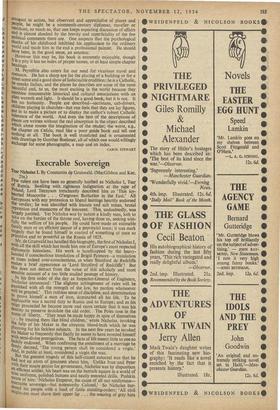Travellers' Lives
Leda and the Goose, By Tristram Hillier. (Longthans. 16s.) South from Naples. By Roger Peyrefitte. (Thames & Hudson. 21s.) MR. HILLIER is lucky as an autobiographer. He lived in Peking as a child and again as a young man and not only do we all want to know about China, but it seems to elicit good descriptive writing, sharp but unemphatic, like the exquisite cultivated landscape: 'the almost ethereal green of the young crops imposed upon a setting of delicate ochre, the subtle patchwork of cotton robes, ceruleum, cobalt and ultramarine, and the occasional resonant note of deep red walls where some temple rises like a flame.' And always in the background of consciousness are the arid mountains and plains and the probability of famine and fighting, so that the scene can never become a toy for the tourist. After Mr. Hillier's description of his time in China, which culminated in his visit to a remote Trappist monastery, the rest of the book is a little disappointing. It contains excellent and often extremely funny stories, admirable descriptions of places and people—strangest of all, the lepers of a Greek island colony—and it is written in the slightly formal style which seems peculiar to painters and which, though it occasionally degenerates into banality, is never pretentious and often strangely clear and vivid in effect. Yet there is a void somewhere in the book. In spite of Mr. Hillier's apparent candour about his work, his religion and his marriages, we are never given any understanding 'of the driving preoccupation of his life. One knows that he is a serious professional painter, but one does not feel that painting is this preoccupation. That may be due simply to a failure in communica- tion but, as one reads his book, the suspicion grows that he belongs to a different type from the modern artist. Adventurous, somewhat arroga at in action, but observant and appreciative of places and DeePle, he might be a nineteenth-century diplomat, traveller or merchant, so much so, that one keeps expecting discussion of affairs and is almost shocked by the brevity and superficiality of the few Political comments there are. One suspects that the psychological shocks of his childhood inhibited his application to the ordinary world and made him in the end a professional painter. He should have been, in the good sense, an amateur.
However this may be, his book is extremely enjoyable, though it is a pity it has no index of proper names, or at least simple chapter headings. M. Peyrefitte also caters for our need for vicarious travel and romance. He has a sharp eye for the placing of a building or for a street scene and a good show of fashionable erudition; he is a Catholic, he speaks Italian, and the places he describes are some of the most beautiful and, to us, the most exciting in the world because they combine innumerable historical and cultural associations with an alien vvarrnth and light. It should be a good book, but it is not. It has no humanity. People are described—sacristans, cab-drivers, Children playing in churches—but one feels that they arc lay figures, Put in to make a picture or to display the author's robust Catholic tolerance of the world. And even the best of the descriptions of Places are written without the real absorption in the object described Which alone rouses the imagination of the reader; the worst, e.g., the chapter on Cefalu, read like a poor guide book and tell one nothing at all. The book is well translated and is ornamented With drawings by Gunther Boehmer, all of which one would willingly exchange for some photographs, a map and an index.
CAROL STEWART



































 Previous page
Previous page